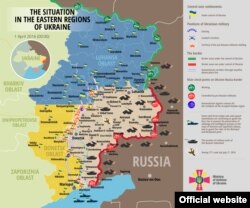International monitors in eastern Ukraine have reported an intense spike in fighting between government forces and Russia-backed separatists as the second year of a shaky truce begins.
"We have seen in the past days and weeks a high number of cease-fire violations, namely in the Donetsk region," Alexander Hug, deputy chief of the Organization for Security and Cooperation in Europe (OSCE) Special Monitoring Mission (SMM) to Ukraine, told RFE/RL on March 30.
Hug said the worst fighting is located between the government-controlled city of Avdiyivka and the town of Yasynuvata, which is held by the separatists. The area is located 17 kilometers north of the city of Donetsk, the regional capital.
"Avdiyivka-Yasynuvata had always been an area that was troublesome, but these types of kinetic activity that we are seeing now is indeed new," said Hug, who added that the overall number of cease-fire violations observed by OSCE monitors began to trend upward in mid-January.
More than 9,100 people have been killed in the fighting in Ukraine’s eastern Donbas region and some 21,000 wounded since the conflict broke out in 2014.
"We have seen all types of different weapons -- we have seen lots of proscribed weapons such as artillery and mortars that should not be there and, of course, not used [based on the Minsk agreement]," Hug said. "We have seen recoilless guns, automatic grenade launchers, heavy machine guns, and small-arms fire there -- and that’s in the hundreds [of firings and explosions] on a daily basis [just in the Avdiyivka-Yasynuvata area]."
Hug added that even "very heavy weapons" -- what he called "the very indiscriminate weapons, the Grad [multiple-rocket launch] systems" -- have been observed by OSCE monitors being used in recent weeks.
The daily violence in the Avdiyivka-Yasynuvata area of the security zone makes up more than half of all the recorded cease-fire violations in the entire Donetsk region, Hug said.
The security zone is a stretch of land that extends 15 kilometers on each side of the line of contact, which was defined in the cease-fire agreement forged in the Belarusian capital, Minsk, by the leaders of Ukraine, Russia, Germany, and France in February 2015.
A key road that snakes past Avdiyivka-Yasynuvata and connects the separatist-controlled cities of Donetsk and Horlivka gives the area a high strategic importance. Another important road heads through the area and goes north.
The area also includes an industrial zone on the edge of Avdiyivka that has been fought over furiously since February, when it was seized by Ukrainian troops.
A map of the security situation in eastern Ukraine on April 1, according to the National Security and Defense Council:
Hug said there is also a water-filtration station near the fighting in Avdiyivka that worries OSCE observers because it provides water to some 400,000 people in the region, on both sides of the line of contact. Chemicals needed for the water station are stored at the site -- including chlorine -- and OSCE officials are concerned that an explosion could ignite the chemicals and lead to an environmental disaster that would also endanger local residents.
"What is happening is that both sides are moving closer to one another toward and onto the contact line, and that brings them too close to each other...and that leads to high tension, which often then erupts into serious fighting," said Hug.
He added that similar tense situations exist near the remains of the Donetsk airport, at a site north of Horlivka, and in the village of Kominternove -- near the southern port city of Mariupol.
"[These] sides [in these areas] are too close to each other, which means they often see each other [from a distance of] less than 50 meters in some places," Hug said.
The one bit of welcome news in the Donbas region, according to the OSCE daily reports, is that there are far fewer cease-fire violations by government troops and the separatists in the Luhansk region.
Another main component of the cease-fire agreement, which is known as Minsk II, is the pullout of heavy weapons from the security zone.
Although the complete withdrawal of heavy weapons by both sides was supposed to be completed more than one year ago, compliance has been spotty.
Hug said that while many of the weapons have been pulled back from the security zone and placed in storage, "we have also seen the reverse trend -- we have seen weapons disappearing from these storage sites and we have seen weapons popping up again in areas where they shouldn't be."
Hug said there have been fewer casualties and less damage to property and infrastructure because of the partial withdrawal of heavy weapons.
The Kremlin has long denied charges by Ukraine, NATO, and many Western countries that Russia has armed the separatists in Donbas and has sent troops there to combat Ukrainian forces.
Hug caused a stir in the Ukrainian media on March 25 when he said at a press conference in Odesa that OSCE monitors in eastern Ukraine had observed evidence of Russian soldiers and weapons "since the beginning of the conflict" that was reflected in the daily reports the monitors compile each day.
Such evidence included, Hug said, "armed people with Russian insignia" on their uniforms and fighters captured by Ukrainian forces "who told us that they are Russian soldiers."
He said OSCE observers had also "seen the tire tracks, not the vehicles themselves, but the tracks of vehicles crossing the border [between Russia and Ukraine]," the Kyiv Post reported.
Hug declined to discuss those comments in a March 30 interview with RFE/RL.
He said the OSCE monitoring mission "reports what it sees" but added that "we don't draw any conclusions and therefore I cannot comment on what the media made out of our [published reports]."














